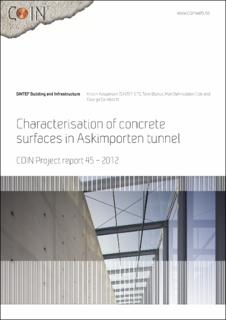| dc.contributor.author | Kaspersen, Kristin | |
| dc.contributor.author | Østnor, Tone Anita | |
| dc.contributor.author | Eide, Mari Bøhnsdalen | |
| dc.contributor.author | De Weerdt, Klaartje | |
| dc.date.accessioned | 2021-10-31T14:52:23Z | |
| dc.date.available | 2021-10-31T14:52:23Z | |
| dc.date.created | 2014-01-06T10:57:30Z | |
| dc.date.issued | 2012 | |
| dc.identifier.isbn | 978-82-536-1312-3 | |
| dc.identifier.isbn | 978-82-536-1311-6 | |
| dc.identifier.issn | 1891-1978 | |
| dc.identifier.uri | https://hdl.handle.net/11250/2826641 | |
| dc.description.abstract | This report gives the findings from a collaboration project between the Norwegian Public Roads Administration (NPRA) and the COIN FA 2.1 project managed by SINTEF Building and Infrastructure which was start in spring 2010.
The COIN FA 2.1 project "Robust and highly flowable concrete with controlled surface quality" is a sub-project of the COncrete INnovation centre (www.coinweb.no) running from 2007-2014. One of the objectives of the COIN FA 2.1 project is to develop an objective classification tool for concrete surfaces cast against smooth formwork. The classification tool should assess pores, grey level and grey level variations. The state of the concrete surface is documented using photographic equipment. The images are analysed using Matlab based image analysis software called BetongGUI. The image taking procedure and image analysis tool were under development during the collaboration project. The NPRA's project "Askimporten tunnel – Field test of surface treatment of wall segments" started in 2010, aims to document the long-term effects of different surface treatment with respect to maintaining a light grey surface colour and reducing the environmental impacts on the concrete elements. In total 9 different surface treatment products were tested.
The NPRA has invited the COIN FA 2.1 project into this collaboration project to document the wall segments with regards to grey level as a case study for implementation of their classification tool.
Regarding the surface treatment products it could be concluded that products 4, 5a and 7 seemed to perform best over time. Product 1a also maintains a lighter visual appearance than the reference before washing, but has similar reflection values as the reference after washing. All these products contain white pigments. None of the colourless surface treatments maintain a lighter appearance than the reference fields over time.
During the collaboration project several improvements were made to the classification tool:
• flash settings are to be kept constant
• a pop-up white calibration object was used during the last site visit instead of white cardboard to prevent folds and hence erroneous reflections
• the grey scale calibration object appeared to be too glossy and therefore only the lightest field of the calibration object is used for greyscale calibration in combination with linearized images
• robustness problems with the white calibration software and image analysis software were dealt with. | |
| dc.language.iso | eng | |
| dc.publisher | SINTEF Building and Infrastructure | |
| dc.relation.ispartofseries | COIN Projet report;45 | |
| dc.subject | Surface specification | |
| dc.subject | Surface treatments | |
| dc.subject | BetongGUI | |
| dc.title | Characterisation of concrete surfaces in Askimporten tunnel: COIN project report 45 - 2012 | |
| dc.type | Research report | |
| dc.description.version | publishedVersion | en_US |
| dc.rights.holder | © 2012 SINTEF Building and Infrastructure | |
| dc.subject.nsi | VDP::Teknologi: 500 | |
| dc.source.pagenumber | 36 | |
| dc.identifier.cristin | 1084053 | |
| cristin.ispublished | true | |
| cristin.fulltext | original | |
